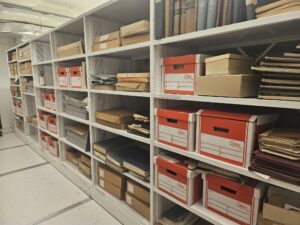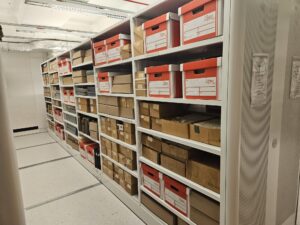In this week’s blog Collections Management Technician Jasmine Hide talks about the rehousing, repitching, and condensing of the Corson collection, and the space saving possibilities of optimal shelf use.
Earlier blog posts of mine and those of the Appraisal Archivist have discussed the necessity of appraisal in ensuring our collections are manageable and space isn’t wasted. There are, however, even more straightforward options for reducing the footprint of a collection, or how much physical shelving space it occupies. Collections arrive to us in every size and shape imaginable, from a slim box of index cards, to a hefty plastic crate, to very large paintings and sculpture. It can be difficult to anticipate and create the ‘ideal’ shelving conditions ahead of a collection’s arrival, and physical arrangement once it has come into our stores is labour intensive work. There are many additional considerations when it comes to arranging collections: will they fit on a standard size shelf? How deep or shallow will the pitch of the shelf need to be? Will the collection need some large plan chest storage, in the case of very large printed material such as maps or drawings?
The Corson Collection is a collection of material related to Sir Walter Scott, gathered by librarian James Clark Corson. Corson, a librarian at the University of Edinburgh, combined his passion for the life and works of Walter Scott with his skills and accuracy in information management to create a vast collection of Scott related materials, now considered one of the most important to exist. Necessarily such a collection contains a wide range of material types, from newspapers to sculpture, not to mention the vast accompanying collection of index cards. In July 2024, the Appraisal Archivist and I set out to see if we could make some improvements to the way a sub-set of the collection was stored in order to replace damaged or harmful enclosures and decrease the physical space the collection occupied.

The Corson Collection prior to our work
There are a number of important things we needed to consider ahead of undertaking this work. First, we consulted the Preventative Conservator to ensure there were no immediate risks to material in the collection that would cause damage if the collection was moved. Next, we talked to the collection curator to ensure that we would not be directly interfering with their work, and to establish if there was any intellectual arrangement expressed by the physical arrangement of the material on the shelves, i.e. does the curator rely on the order things are shelved in to determine the ‘intellectual’ groupings of the material, for example by shelving all biographical material in one area and all memorabilia in another? We next ensured we would have enough physical space to move the collections around and would not be directly interfering with other activities taking place within the store, and finally that we had enough material available to us to carry out some basic rehousing, primarily moving material from broken, damaged, or damaging enclosures into our standard acid neutral archive boxes.
The process itself involved moving through the collection on a shelf-by-shelf basis. On each shelf, we would assess the need for any material to be reboxed, the amount of empty space on the shelf which could accommodate material from other nearby shelves, and how high or low the shelf was pitched. On occasion we would also decide a shelf was overcrowded and so the material would need to be separated and spaced out. One by one, we shuffled the contents of the shelves along, playing a tetris-like game of rearranging to determine how much material we could comfortable and safely accommodate on a shelf. As we went, we made sure to keep a record of the precise location of each container to ensure all material would still be findable after the move.

The Corson Collection after work was complete
The results of the move were a significant improvement to the accessibility and long-term preservation of material on the shelves, as you can see in the before and after images. Without conducting any appraisal, we were able to save 18 linear metres of space. That’s enough room for 54 more archive boxes! Undertaking this work really demonstrated to me how much we can achieve by spending some extra time puzzling out not just what goes into our stores, but the way it goes in. We hope to replicate this kind of work across more collections – who knows how much more room we might save along the way!
